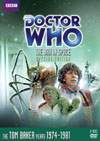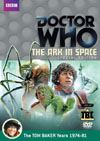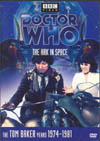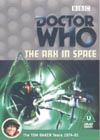Special Edition DVD Extras include:
The three regular characters proceed to carry the first episode all on their own, and do a remarkably fine job of it. In many ways, it is reminiscent of "The Edge of Destruction" (story no. 3), a pause in the heavily populated adventures to give the regulars time to define their characters and relationships with each other. The sets by Roger Murray-Leach are really wonderful, helping to set the story apart from the usual outer space boxes seen previously on the program. It's doubly nice that the sets got re-used again in the final story of the season.
What's your genre?It's interesting to hear Philip Hinchcliffe's commentary on how he aimed to take the show more solidly into the realm of sci-fi, because his definition of certain genres is different from mine, as everyone's definitions are always at least slightly different. For me, the Barry Letts / Terrance Dicks / Jon Pertwee years were well-rounded, solid sci-fi years in terms of genre, often with social/moral conscience aspects integral to the plot and basic premise. The Hinchcliffe years tip the sci-fi scale in favour of horror in my view. Not slash-fest terror, mind you, because I never was frightened, and never knew anyone who "hid behind the couch", but horror, because disturbing things happen to people, and it shouldn't, and it makes you think afterwards how awful it would be to experience it, and what you might do if you were in the position of this character or that one. The moral compass in the Hinchcliffe years is much more reactionary - it rests more in the characters' responses to the sci-fi/horror concepts they encounter, rather than in the inception of the concepts themselves.Further on, the Graham Williams years (seasons 15-17) would tip the sci-fi scale in the other direction, more towards humour and fantasy, where one can escape to a fun place with colourful light-hearted effects, and fill the moral commentary on society with irony and satire. To be quite frank, more my own personal cup of tea. And lastly, the John Nathan-Turner years (seasons 18-26) seem to return to the centre of balance in my idea of sci-fi, where an additional push was made to give it all a big blockbuster, sequels-to-outdo-originals type of feel, a push that eventually overshadowed the sci-fi elements altogether but still gave us lots of great fun stuff. "The Ark in Space" really is a bold statement of the way Hinchcliffe and Holmes wanted to do things, and the change in atmosphere really is quite palpable. It's a riveting bottle-story, well-paced, and superbly delivered by the actors. Tom Baker finds himself in his new role, and Ian Marter finally gets lots of screen time to demonstrate how exceptionally good he is in his role. Elisabeth Sladen has less to do as Sarah, but still does it all extremely well. Richardson Morgan is great as Rogin, the one futuristic "awakened-human" character who seems to still have wit and emotional depth. Morgan was also very entertaining as Corporal Blake in the 1967 Pat Troughton story "The Web of Fear" (story no. 41). Wendy Williams plays Vira with a certain futuristic distance in her mannerisms, aiding that early sense of uncertainty as to whether the chief threat against the Doctor's party will come from the awakened humans themselves, caught in the grip of the automation and purification of their culture, or some other unknown..... As Noah, Kenton Moore has to continue to pull off that dichotomy all the way through, and he does a remarkable job of it. They say Tom Baker was unpredictable in humorous ways, which was probably true, but so were Noah and Vira in dramatic ways as characters, which fuels so much of this story's power. Many of the effects are limited, but director Rodney Bennett seems extremely expert in knowing what to do with what he gets. The "line-of-fire" visible beams that I always want to see aren't there, but particularly with the battles involving the "heavier artillery" of the fission guns, the fast-editing, close-ups, powerful sound effects, and visuals of sparks around the targets and interesting working props all combine to deliver a wonderful and absolutely essential energy to the drama. I love those sequences. They work, and with a different variety of cinematic ingredients than the usual sci-fi palette. It's so much better than much of what Doctor Who had been offering us previously in terms of fire-fights. It keeps the drama moving as it should, which Bennett has done a remarkable job on as a whole.
The Rise of the TransmatHere comes another big plus for the story: Trans-mat finally comes of age. They may have screwed up with the TARDIS effects, but for the first time in the history of the show, Doctor Who's version of Star Trek's "beam-me-up" transporter is done to satisfaction with a proper trick-dissolve. Trans-mat features quite a bit in this story, and is nicely integral to the link to the next stories. I am disappointed, however that Trans-mat took over from the TARDIS as the main vehicle moving our main characters from one story's setting to the next; I think an interesting move like that would be more appropriate for a new Doctor's second season than his first, again in the interests of "piloting" the show to new audiences and doing the TARDIS right first until it is a better established familiarity.Ian Marter, God bless him, made a wonderful and critically more logical improvement on it in his novelization of this story and the next. If the transmat is not working so well, why use it to get to the problem on the other end, when the TARDIS is sitting right there begging to be the hero? Marter's version uses it, and concocts a technical reason for it abandoning the trio on Earth to return to the Ark. This heightens the sense of them being trapped on Earth, because it would show that they're not willing to trust the transmat until after the Doctor has finished fixing it, and it also provides a reason for the TARDIS to be in motion to return to the Ark in the appropriate time period for "Revenge of the Cybermen" (story no. 79), rather than having us believe that after it was just sitting there after "The Ark in Space" it spontaneously decided to get up and shift back through time. So.... three cheers for Ian Marter, and too bad he wasn't quick enough with that one to get it into the filming and taping of the season.
This story has become available on DVD and VHS video. Click on the Amazon symbol for the location nearest you for pricing and availability:
| |||||||||||||||||||||||||||||||||||||||||||||||












